Related Research Articles

The Buthidae are the largest family of scorpions, containing about 100 genera and 1339 species as of 2022. A few very large genera are known, but a high number of species-poor or monotypic ones also exist. New taxa are being described at a rate of several new species per year. They have a [cosmopolitan] distribution throughout tropical and subtropical environments worldwide. Together with four other families, the Buthidae make up the superfamily Buthoidea. The family was established by Carl Ludwig Koch in 1837.
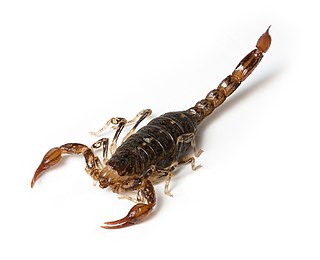
Cercophonius squama, commonly known as the forest scorpion or wood scorpion, is a scorpion native to south-eastern Australia. It is typically around 25–40 mm (0.98–1.57 in) long. Its colour consists of different shades of brown.
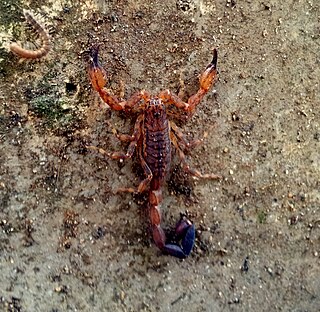
Reddyanus besucheti is a species of scorpion in the family Buthidae endemic to Sri Lanka.
Isometrus thwaitesi is a species of scorpion in the family Buthidae endemic to Sri Lanka.

Urodacus is a genus of scorpion belonging to the family Urodacidae. It was described by German naturalist Wilhelm Peters in 1861. The type species is U. novaehollandiae. Its species are native to Australia, and dig burrows. The genus was placed in its own family in 2000. Before this, the group had been a subfamily Urodacinae within the family Scorpionidae.
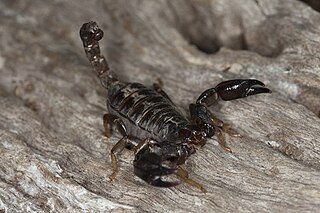
Urodacus manicatus, commonly known as the black rock scorpion, is a species of scorpion belonging to the family Urodacidae. It is native to eastern Australia.

Urodacus yaschenkoi, also known as the inland scorpion or the desert scorpion, is a species of scorpion belonging to the family Urodacidae. It is native to central Australia. It is also referred as the desert robust scorpion, because of its robust black colour and a long tail lined with a deadly hook.
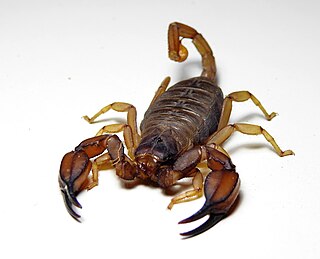
Urodacus elongatus, commonly known as the Flinders Range scorpion, is a species of scorpion belonging to the family Urodacidae. They are endemic to the Flinders Ranges of South Australia. They were described by L.E. Koch in 1977.

Hormurus karschii is a species of scorpion belonging to the family Hormuridae.

Hormurus is a genus of scorpions, commonly known as rainforest scorpions, in the family Hormuridae, that occur in rainforest habitats, mainly in Australia and Melanesia. The genus was first described by Swedish arachnologist Tamerlan Thorell in 1876.
Wilson R. Lourenço is a French-Brazilian arachnologist specializing in scorpions.
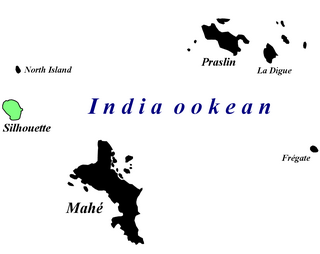
Afrolychas braueri, commonly known as the Seychelles forest scorpion, is a species of scorpion in the family Buthidae. It is currently thought to survive only on Silhouette Island, Seychelles, although the species was historically found on two additional Seychellois islands. This scorpion lives in leaf litter in forests that are largely unaffected by invasive plant species. It is a small yellowish-brown scorpion with three prominent keels on the dorsal surface of its mesosoma, which distinguishes it from other scorpions. While not much is known about the Seychelles forest scorpion's ecology due to the paucity of sightings, it is known to rely solely on its venom to capture its prey and defend its young. Its venom is not dangerous to humans.
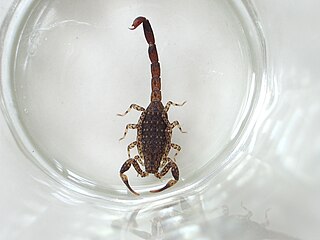
Lychas is a genus of scorpions belonging to the family Buthidae. It is one of the most widespread genus of the scorpions, where the species are found throughout in Africa and Seychelles, and in the Oriental region from India to Melanesia.
Isometrus kovariki is a species of scorpion in the family Buthidae. It was identified in and currently found only in a small region of Southern Karnataka, in an Acacia auriculiformis plantation, and it is closely related to Isometrus thurstoni, a species of scorpion endemic to the Western Ghats region of India.
Isometroides is a genus of scorpions in the Buthidae family with two species. It is endemic to, and found widely across, inland mainland Australia, and was first described by German arachnologist Eugen von Keyserling in 1885.
Isometroides vescus, also known as the spider-hunting scorpion or spiral burrow scorpion, is a species of scorpion in the Buthidae family. It is native to Australia, and was first described by German arachnologist Ferdinand Karsch in 1880.
Isometroides angusticaudus, also known as the slender spider-hunting scorpion, is a species of scorpion in the Buthidae family. It is native to Australia, and was first described by German arachnologist Eugen von Keyserling in 1885.
Lychas buchari, also known as the yellow sand scorpion, is a species of small scorpion in the Buthidae family. It is native to Australia, and was first described in 1997 by Czech arachnologist Frantisek Kovarik.

Cercophonius is a genus of six species of Australian scorpions, often termed wood scorpions, in the family Bothriuridae.
References
- ↑ "Checklist for SCORPIONES". Australian Faunal Directory. Department of the Environment, Water, Heritage and the Arts, Australian Government. Retrieved 18 April 2008.